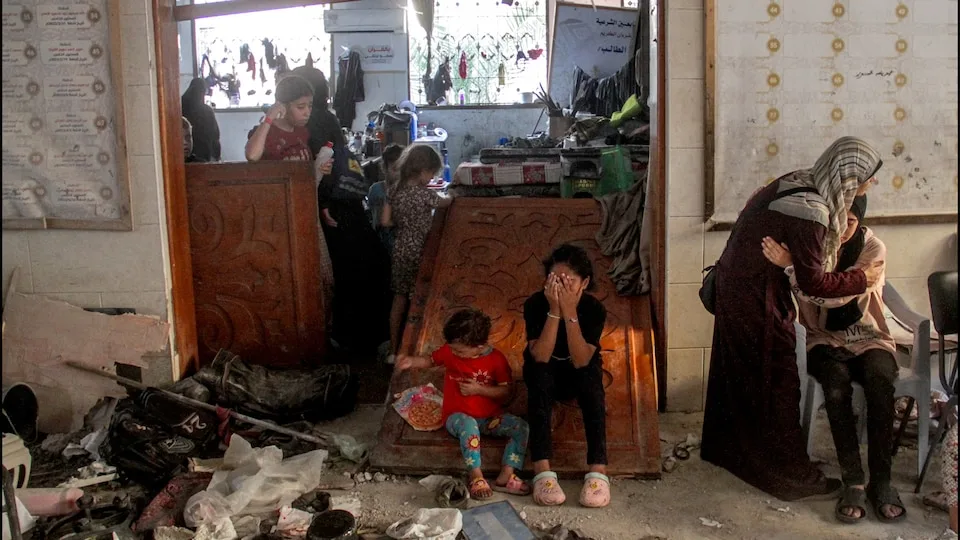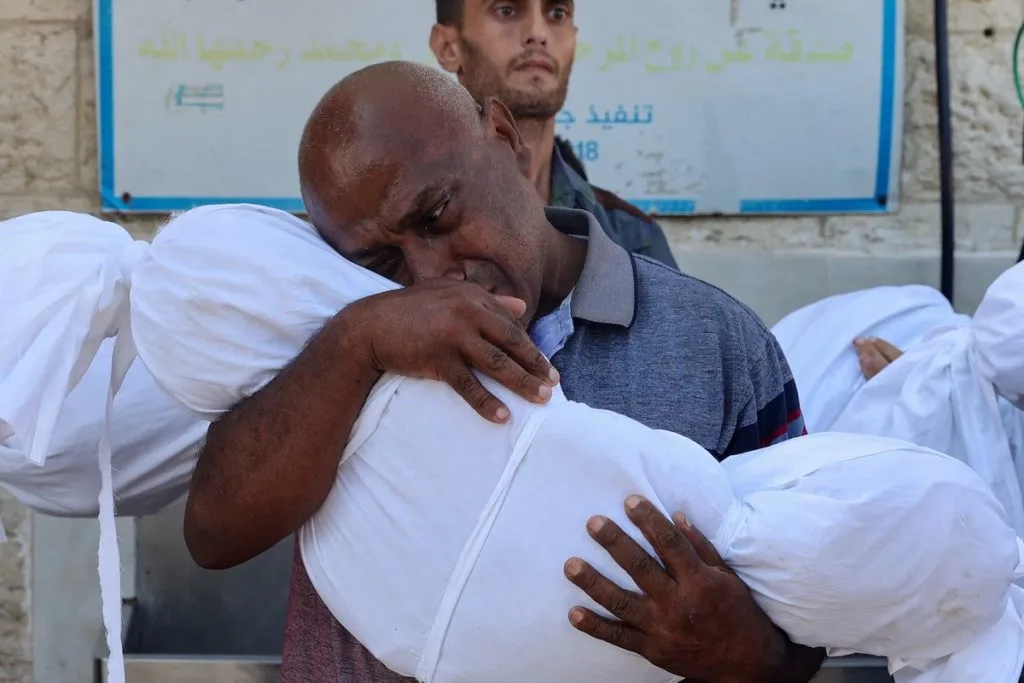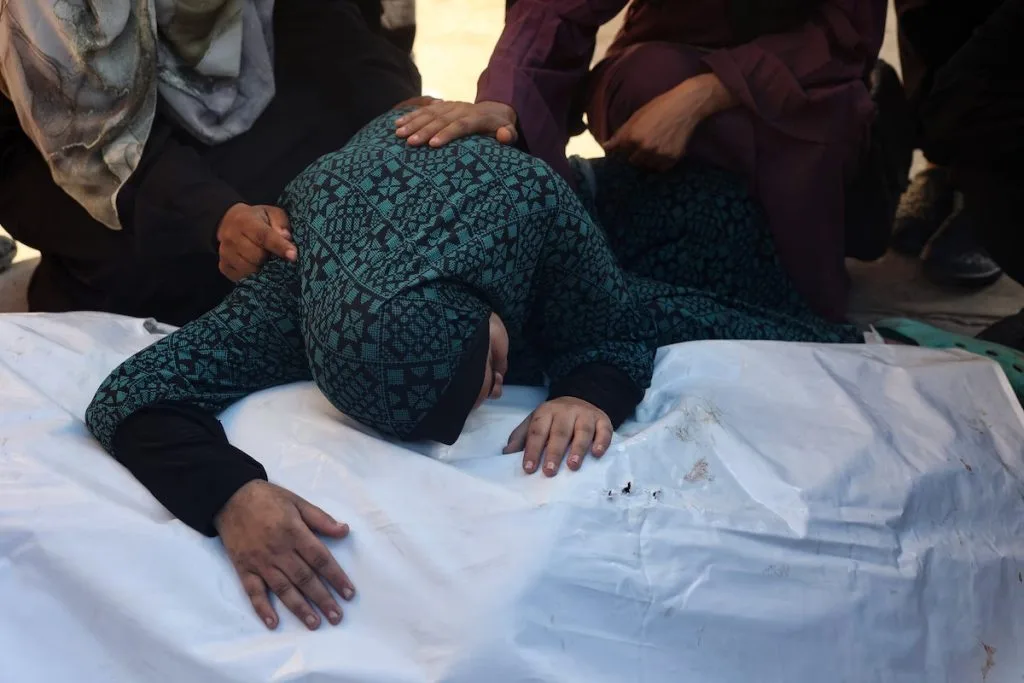
The Israel Defense Forces said Hamas fighters had been operating in the Gaza City school. Eleven children and six women were among those killed, a Gaza official said.

By Missy Ryan, Hajar Harb, Mohamad El Chamaa, Adela Suliman and Kelsey Ables, Washington Post, August 10, 2024
JERUSALEM — An Israeli strike on a school sheltering displaced Palestinians killed at least 93 people in the Gaza Strip on Saturday, civil defense authorities said, deepening global scrutiny of Israel’s conduct of the war more than 10 months into its campaign to eliminate Hamas.
Gaza civil defense spokesman Mahmoud Bassal said the al-Taba’een school in Gaza City was housing about 6,000 displaced Palestinians when the bombs struck around 4:30 a.m. He said at least 11 children and six women were among those killed, with at least 54 injured and dozens missing.
Video from the scene showed scores of bodies wrapped in sheets and blankets laid in the schoolyard after the strike, as women crouched over corpses in grief. The strike was one of the single deadliest bombings of the war, and Bassal said the toll was expected to rise. “The recovery operations are indescribable,” he said in an interview.
The Israel Defense Forces said the strike targeted Hamas and Islamic Jihad militants it claimed were operating a command and control node from within the school, accusing the group of using civilians as human shields.
An Israeli military official, who spoke on the condition of anonymity in line with IDF protocol, said that three precision munitions struck a prayer hall, which he said was used by militants, on the ground floor of the three-story school building. Residents said the facility had been converted into a shelter for Gazans forced to flee their homes.
The strike, two days after a dozen people were killed in two earlier Israeli strikes on Gaza schools, came at a delicate moment for the government of Prime Minister Benjamin Netanyahu, who is already under pressure to end a conflict that has left tens of thousands of people dead and plunged the Middle East into a period of renewed upheaval and violence.
In a bid to halt the fighting, the Biden administration has spearheaded an intense diplomatic campaign in recent days to compel the two sides to reach a deal that would stop the war and see Israeli hostages released. U.S. officials have likewise been racing to head off a wider regional conflict, as Iran and Lebanon’s powerful paramilitary force Hezbollah promise to attack Israel over recent strikes on militant leaders.
The site of Saturday’s bombing in Gaza City, and the scale of the bloodshed, brought a swift international response.
The United States, Israel’s closest ally, expressed concern about the strike and said it had asked for more information. Like other nations that have backed Israel’s response to Hamas’s brutal attack on Oct. 7, Washington has blamed the militant group for using civilian sites to mask its military activities, but has also called on Israel to do more to keep noncombatants safe.
“Far too many civilians continue to be killed and wounded,” National Security Council spokesperson Sean Savett said in a statement. “This underscores the urgency of a cease-fire and hostage deal.”
Foreign Secretary David Lammy of Britain, another key Israeli ally, said he was “appalled” by the incident. “Hamas must stop endangering civilians. Israel must comply with international humanitarian law,” he wrote on social media.
France decried the targeting of Gaza schools and what its Foreign Ministry called Saturday’s “intolerable” death toll.
The governments of Qatar, Egypt and other Arab nations meanwhile responded with outrage. “This is an indication that the Israeli government seeks to thwart and frustrate [cease-fire] efforts,” Jordan’s Foreign Ministry said.
Several eyewitnesses described a terrifying series of events during the strike, which occurred in morning darkness when some people were performing dawn prayers and others were asleep.
The windows of Amjad al-Sheikh’s nearby home shattered. “My body flew through the air from the force of the explosion,” he said.

Sheikh, 32, and two of his brothers rushed to the school to help with rescue efforts, where they used the light from their phones “to track the voices of the wounded, including children and women asking for help to save their lives.”
Hashem Hamada, 31, a photojournalist who also lives close to the school, raced to the school after been awoken by the explosion. He said he helped retrieve 10 bodies, including that of a child.
Most of the wounded were transported to nearby al-Ahli hospital. Motasim Dalloul, 45, whose child once attended classes at the Taba’een school, spoke to The Washington Post from inside the hospital, where he saw dozens of wounded. “People were crying and wailing,” he said.

Fares Afana, director of ambulance and emergency services in northern Gaza, said that bodies were splintered by the strike. “No matter how many words we say about this scene, it is indescribable,” he said.
He said the medical response was made more difficult by the severe degradation of Gaza’s emergency infrastructure, including the destruction of most of the territory’s ambulances.
Tamer Kirolos, regional director for Save the Children, an aid organization, said it was the deadliest attack on a school in Gaza since October.
“All parties must respect the protected status of schools and not use schools as battlegrounds,” Kirolos said in a statement.
The U.N. Human Rights Office earlier this week reported that at least 17 schools in Gaza had been targeted in the past month, saying that the reported deaths from those strikes suggested “a failure to comply with the principles of distinction, proportionality, and precautions in carrying out these attacks.”
The IDF said that Hamas had increasingly been “focused on exploiting school buildings, often where civilians are sheltering inside, to use them as military facilities, command and control centers, for storing weapons, and to execute terrorist attacks.”
It said the weapons employed in the strike “cannot cause the amount of damage that is being reported” by authorities in Gaza.
After the strikes on other Gaza schools earlier this week, the IDF said those sites, too, were being used by Hamas.
Weapons experts suggested that Israel may have employed a GBU-39 small diameter bomb, a U.S.-made precision weapon, in the strike but said that even guided munitions require civilian harm analysis before being used.
“Even where a relatively small munition is selected, the possibility of civilian harm can often be foreseen and should be considered in the specific context of the target and its surrounds,” said N.R. Jenzen-Jones, director of Armament Research Services.
Israel’s targeting practices in Gaza have generated widespread criticism since the early days of the war. Rights groups have accused Israel of violating international law and even called on the United States to suspend arms sales. The Biden administration itself said it was likely Israel had violated the laws of war in Gaza though it has not reached conclusions in specific cases.
While the Israeli government has frequently rejected reports of civilian deaths in Gaza, Netanyahu in a recent interview with Time magazineappeared to acknowledge that some 20,000 civilians have died in the war, saying Israel believed there had been a “one-to-one” civilian-to-combatant death ratio.
The incident has the potential to further inflame tensions between Israel and Washington.
While the United States has long called on both Israel and Hamas to accept the cease-fire proposal, some U.S. officials have grown frustrated with Netanyahu’s stance in recent weeks, complaining that the Israeli leader, under pressure from right-wing members of his governing coalition, has sought to improve the terms for Israel after President Joe Biden publicly laid out a cease-fire framework in May.
Hoping to shatter the impasse, the United States, Qatar and Egypt, which have all played a role in mediating talks, issued a joint statement this week urging both sides to return to the negotiating table on Aug. 15. “There is no further time to waste nor excuses from any party for further delay,” the three countries’ leaders said.
Netanyahu’s office has said that Israel will send representatives to the talks “to finalize the details for implementing the framework agreement.” Hamas gave no immediate response.
The U.S.-Israeli friction was likewise visible on Friday when the White House lambasted one of Netanyahu’s ministers for his critical statements about the proposed cease-fire agreement.
National Security Council spokesman John Kirby took the unusual step of singling out an Israeli cabinet member, saying that comments by Finance Minister Bezalel Smotrich were “outrageous and absurd.”
U.S. Ambassador to Israel Jack Lew told Israeli media that comments by Smotrich, who said the deal would amount to a “surrender to Hamas,” could put Israel “at strategic risk.”
Smotrich hit back on social media, saying that the criticism would not change his stance.
“Just as the U.S. would reject international pressure to reach a surrender agreement with Al Qaeda and [Osama] bin Laden, so Israel will not submit to any external pressure that would harm Israel’s security,” he said, referring to the militant leader the U.S. military killed in 2011.
Harb and Suliman reported from London, El-Chamaa from Beirut and Ables from Seoul.
Leave a Reply
You must be logged in to post a comment.